Higher efficiencies for solar cells and thus a faster expansion of photovoltaics and an acceleration of the energy transition – This is the objective of the researchers at Fraunhofer ISE when working on tandem photovoltaics. They will present the latest results of their work on tandem solar cells of different material classes at the European Photovoltaic Solar Energy Conference and Exhibition EU PVSEC, which will be held online from September 7-11, 2020.
Reducing the cost of solar power and increasing efficiency has always been a major motivation in solar cell research. Since the efficiency of the market-dominant silicon technology – whose continuous development has led to solar electricity prices of less than 5 eurocents per kilowatt hour even in Germany today – is nearing its theoretical limit, numerous research institutions are currently pursuing the tandem approach. This involves combining different semiconductor materials to form a tandem of two or more solar cells in order to make better use of the solar spectrum. Each of the materials used converts a different region of the solar spectrum into electrical energy. For solar cells made of only silicon, the physical-theoretical limit is around 29 percent. Research and industry have already reached the economically feasible limit here with industrial-standard solar cell efficiencies of 26 percent.
“In our research on tandem photovoltaics at Fraunhofer ISE, we are pursuing the approach of combining a silicon base cell with III-V semiconductors or perovskites to form a monolithic tandem solar cell, which subsequently looks no different from a cell consisting solely of silicon,” says Prof. Dr. Stefan Glunz, head of the Photovoltaics Research Division at Fraunhofer ISE. “By utilizing the properties of both layers, we can achieve significantly higher efficiencies. In our new Center for High Efficiency Solar Cells soon to be completed, we will have state-of-the-art clean room equipment with which we can meet the challenges of the rapidly developing tandem photovoltaics even better.”





























